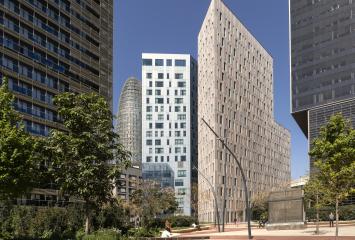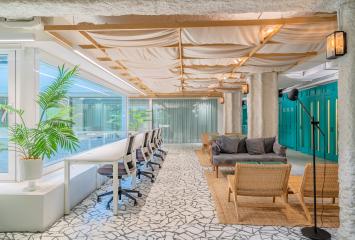Tips for Achieving a Truly Biophilic Design
The first signs that the population was burning out came in the second half of the 20th century as cities became excessively urbanized and far removed from nature. As the renowned psychoanalyst Erich Fromm concluded in 1973, human beings are inherently biophilic, with a genetic predisposition to bond with plants and life in general, and the concrete and steel design of the cities repeatedly contradicted that instinct, undermining people’s productivity, creativity and emotional satisfaction. Fromm died in a small township in Switzerland in 1980, but the great socio-biologist Edward O. Wilson continued to advocate biophilia.
And fortunately it began to catch on at the companies of the real estate industry. Today many offices incorporate significant biophilic aspects with special nature-like designs, installing fountains and other water features, using colors common in natural ecosystems and materials such as wood, and creating air flows that replicate those in nature. However, there is one problem: Often the commitment to biophilia is superficial, with designs that fail to take into account the key factors closely linked to environmental sustainability. This is called ‘greenwashing’.
Biophilic design must go beyond appearances
For employees, biophilic appearance at the office is certainly important for the quality of work. As we explained in another of our articles, biophilia at the office increases the sense of well being by 15%, creativity by 15% and productivity by 6%. These figures cannot be ignored. However, appearances are only part of the commitment to biophilia. Any design that truly aspires to connect people with their inherent need for nature at the workplace must “take into account the environmental impact of each feature that is incorporated,” as AllWork points out. A fountain that is not ecological serves no purpose.
In this regard, HED's National Sustainable Design Leader Daniel Jaconetti says there are several practices that are essential for biophilic design beyond the creation of an organic and natural appearance. These include the use of materials with low carbon content such as mass timber, rammed earth, cotton, linoleum, cork, stone or clay. And if “a natural material is not the right fit, then we should focus on reclaimed materials to limit the carbon footprint.” LED lighting, thermal insulation and an optimal use of natural light are essential.
Moreover, the biophilic approach should also involve the proper selection of plants to be included in the design. On the surface, any plant increases the personal sense of connection to nature. However, a plant from a totally different ecosystem will probably be less sustainable in terms of water use. Also in terms of the relationship with wildlife. This particularly applies to outdoor green office breakout areas. The biophilic design should be ambitious. And the BREEAM, LEED or WELL certifications we use at Colonial are very precise mechanisms for measuring the results. They take global biophilia into account.
The Importance of Communication in Personal Biophilia
An office wall covered in climbing plants is obvious. So is wooden furniture. Employees perceive this and feel their biophilia is satisfied. But this is not true of many of the other biophilic elements we have mentioned in this article. Unless you are an expert in the field, it is not immediately apparent that the insulating materials behind a wall have a low carbon footprint. Or that a plant is indigenous. Or that the layout with respect to the sun optimizes radiation and reduces the consumption of the air conditioning systems. Such details are crucial but go unnoticed unless they are communicated.
It is important to communicate them. Because these design decisions are essential in biophilic architecture, and some of them do not lead to a direct positive impact on people's well being. The aim of these choices is to avoid making global warming worse and to reduce the building's impact on climate change. Something that is of great value. Particularly for the employees, who are morally uplifted by the knowledge that they work in an office that is so environmentally responsible. It strengthens the connection they feel with nature. Their bond with the planet. Their sense of belonging. True biophilia is not aesthetic. Nor is it an option. It is the way forward.

